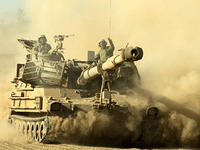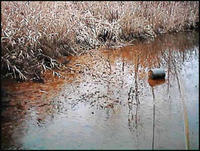-
Israel, for the first time since the October 1973 war, fires warning shots into Syria

The civil war in Syria has taken an ominous turn on Sunday as Israel, for the first time since the October 1973 Yom Kippur war, fired into Syria to warn the beleaguered Assad government that Israel would not tolerate shelling from Syrian territory into Israel; on four separate occasions last week, mortars from Syria fell in the Golan Heights, an area Israel captured from Syria in the 1967 war; it appears that the mortar fire was not intentional, but rather stray rounds, the result of errand shelling; on Saturday nine days ago, a few Syrian tanks entered a no-man’s land near the Israel border, in violation of the 1974 cease-fire and force-separation agreement between Israel and Syria
-
-
U.S.-Iran tensions rise as Iran tries to disrupt U.S. reconnaissance flights in Gulf
Tensions between the United States and Iran increase as news emerged last week of an attempt by four Iranian fighter planes, on 1 November, to shoot down a U.S. Predator drone engaged in a surveillance mission over international water in the Persian Gulf
-
-
CIA-commissioned climate change report outlines perils for U.S. national security
U.S. national security leaders believe that the accelerating pace of climate change will place severe strains on U.S. military and intelligence agencies in coming years; the reason, according the National Research Council, the U.S. top scientific research body: climate changes will trigger increasingly disruptive developments around the world; a 206-page National Research Council study, commissioned by the CIA and other U.S. intelligence services, concludes that states will fail, large populations subjected to famine, flood, or disease will migrate across international borders, and national and international agencies will not have the capacity or resources to cope with the resulting conflicts and crises
-
-
Supreme Court to hear police DNA-collection case
The United States Supreme Court last week granted certiorari in Maryland v. King; in the case, Maryland law enforcement stands to lose the right to require a DNA collection as part of booking procedures for certain felony crimes; a similar law was passed by Congress in 2004 for federal arrests, and twenty-four other state legislatures have also passed such laws
-
-
Cleanup of most contaminated U.S. groundwater sites unlikely for many decades

At least 126,000 sites across the United States have contaminated groundwater that requires remediation, and about 10 percent of these sites are considered “complex,” meaning restoration is unlikely to be achieved in the next 50 to 100 years due to technological limitations; the estimated cost of complete cleanup at these sites ranges from $110 billion to $127 billion, but the figures for both the number of sites and costs are likely underestimates
-
-
Nanostructured material stronger than a speeding bullet
Providing protection against impacts from bullets and other high-speed projectiles is more than just a matter of brute strength; while traditional shields have been made of bulky materials such as steel, newer body armor made of lightweight material such as Kevlar has shown that thickness and weight are not necessary for absorbing the energy of impacts; new tests of nanostructured material could lead to better armor against everything from gunfire to micrometeorites
-
-
DARPA seeks multi-band, portable sensor to provide soldiers with clear images
Clip-on or helmet-mounted camera system would fuse useful aspects of visible, near infrared, and infrared images into a single shot under all weather and visibility conditions; the Pixel Network for Dynamic Visualization program, or PIXNET, technology would ingest the most useful data points from each component sensor and fuse them into a common, information-rich image that can be viewed on the soldier’s heads-up display, and potentially be shared across units
-
-
New strategy for fingerprint visualization
Identifying fingerprints on paper is a commonly used method in police forensic work, but it is not easy to make those fingerprints visible. Now, scientists have developed a new approach for making such fingerprints more readily readable
-
-
Flying robot avoids obstacles
Researchers have created an autonomous flying robot which is as smart as a bird when it comes to maneuvering around obstacles; able to guide itself through forests, tunnels, or damaged buildings, the machine could have tremendous value in search-and-rescue operations
-
-
DHS grants help Kansas Law enforcement agencies buy new equipment
DHS grants help local law enforcement agencies fight crime more effectively, but according to some, those same agencies are bypassing military grade surplus equipment for brand new shiny toys
-
-
"Stutter jump" could improve performance of search and rescue robots
A new study shows that jumping can be much more complicated than it might seem; in research that could extend the range of future rescue and exploration robots, scientists have found that hopping robots could dramatically reduce the amount of energy they use by adopting a unique two-part “stutter jump”
-
-
Smart camera to describe what it sees -- and reason about what it cannot see
Army scouts are commonly tasked with covertly entering uncontrolled areas, setting up a temporary observation post, and then performing persistent surveillance for twenty-four hours or longer; what if instead of sending scouts on high-risk missions the military could deploy taskable smart cameras? A truly “smart” camera would be able to describe with words everything it sees and reason about what it cannot see
-
-
Approaches to international consequence management for CBRNE incidents
The National Research Council (NRC) of the National Academy of Sciences, through a grant sponsored by NIST’s Office of Law Enforcement Standards (OLES), is organizing an effort to understand the metrics and measures that are needed to develop standards of response that will support the basic capabilities of a country or region to respond to a chemical, biological, radiological, nuclear, or explosive (CBRNE) incident
-
-
Technology used in BioWatch could not detect pathogens, issued false alarms
The BioWatch program was created to detect the release of pathogens in the air as part of a terrorist attack, but scientists say that the program is unable to detect lethal germs because the system uses defective components; these components often set off false alarms; for example, BioWatch sensors issued fifty alarms between 2003 and 2008, but scientists and security authorities never had enough confidence in the BioWatch system to evacuate an area or take other emergency steps
-
-
CHAMP, Boeing’s non-kinetic alternative to traditional explosive, in first operational test
CHAMP, Boeing’s counter-electronics weapon system, uses high-powered microwaves to degrade or destroy electronic targets without collateral damage; it was recently successfully passed its first operational test at the Utah desert
-
More headlines
The long view
Tantalizing Method to Study Cyberdeterrence
Tantalus is unlike most war games because it is experimental instead of experiential — the immersive game differs by overlapping scientific rigor and quantitative assessment methods with the experimental sciences, and experimental war gaming provides insightful data for real-world cyberattacks.
Using Drone Swarms to Fight Forest Fires
Forest fires are becoming increasingly catastrophic across the world, accelerated by climate change. Researchers are using multiple swarms of drones to tackle natural disasters like forest fires.
Testing Cutting-Edge Counter-Drone Technology
Drones have many positive applications, bad actors can use them for nefarious purposes. Two recent field demonstrations brought government, academia, and industry together to evaluate innovative counter-unmanned aircraft systems.
European Arms Imports Nearly Double, U.S. and French Exports Rise, and Russian Exports Fall Sharply
States in Europe almost doubled their imports of major arms (+94 per cent) between 2014–18 and 2019–23. The United States increased its arms exports by 17 per cent between 2014–18 and 2019–23, while Russia’s arms exports halved. Russia was for the first time the third largest arms exporter, falling just behind France.
How Climate Change Will Affect Conflict and U.S. Military Operations
“People talk about climate change as a threat multiplier,” said Karen Sudkamp, an associate director of the Infrastructure, Immigration, and Security Operations Program within the RAND Homeland Security Research Division. “But at what point do we need to start talking about the threat multiplier actually becoming a significant threat all its own?”
The Tech Apocalypse Panic is Driven by AI Boosters, Military Tacticians, and Movies
From popular films like a War Games or The Terminator to a U.S. State Department-commissioned report on the security risk of weaponized AI, there has been a tremendous amount of hand wringing and nervousness about how so-called artificial intelligence might end up destroying the world. There is one easy way to avoid a lot of this and prevent a self-inflicted doomsday: don’t give computers the capability to launch devastating weapons.
